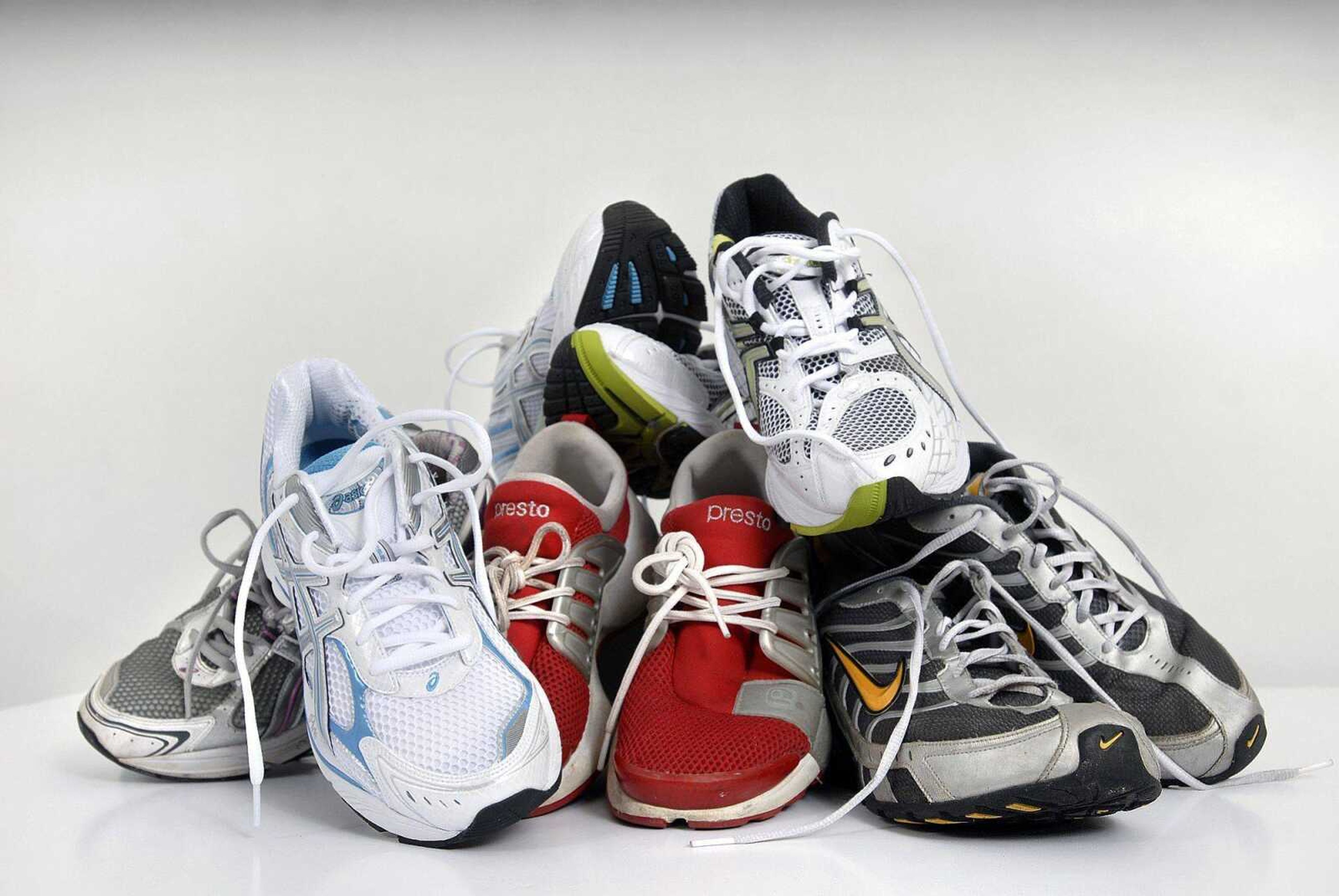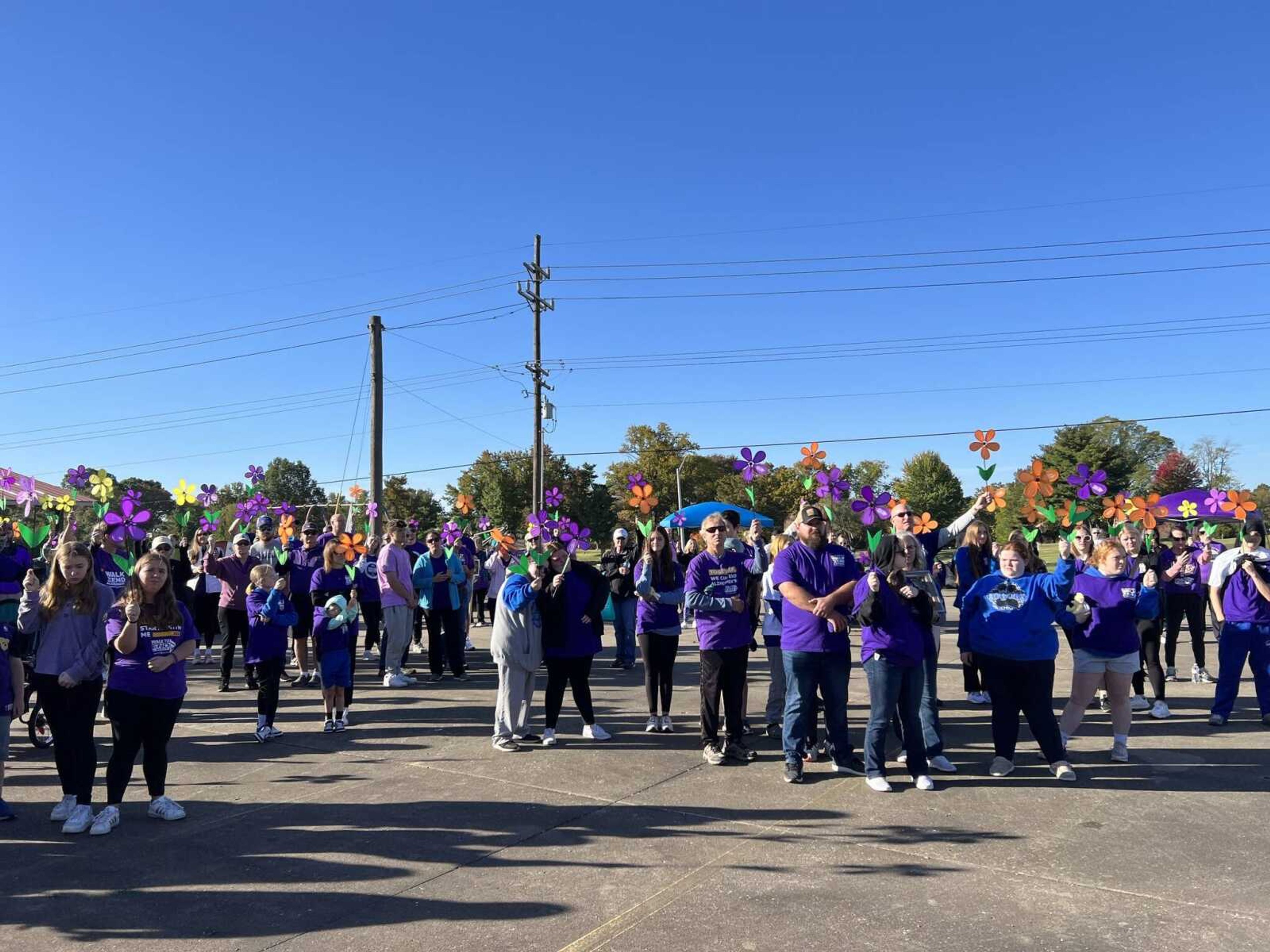Choosing the proper shoe key to keeping feet happy
Although it may be tempting to splurge on a collection of flip-flops in every color or a new pair of classic canvas tennis shoes in anticipation of warm weather, experts agree wearing a more supportive shoe is important to maintaining the overall health of feet and legs...
Although it may be tempting to splurge on a collection of flip-flops in every color or a new pair of classic canvas tennis shoes in anticipation of warm weather, experts agree wearing a more supportive shoe is important to maintaining the overall health of feet and legs.
Dr. Zenon Duda, a Cape Girardeau podiatrist, said in order for someone to understand how to choose the right shoes, they must first know how the foot functions when a person takes a step.
"The foot is like a complex tripod," Duda said, "with the heel and a toe on each side of the foot making up the legs of the tripod."
When a person takes a step, the weight of the body needs to distribute itself evenly throughout the foot.
In a shoe with a flimsy sole, such as flip-flops or canvas tennis shoes with a thin sole, the foot isn't receiving good support, Duda said.
Jason Longwith, manager of Brown's Shoes in Cape Girardeau, said talking to someone knowledgeable, getting feet measured and considering the purpose, such as walking or running, will result in finding the best shoe.
"Wearing the wrong shoe can have a lot of short-term and long-term effects, on not just the feet and legs but the entire body, such as problems with the knees and hips," Longwith said.
According to Longwith, feet should be considered a base for the body comparable to the foundation of a house.
"If the feet aren't working properly, the rest of the body won't be able to, either," he said. "It's possible to find the right shoe but not realize it's the wrong size."
Improper size will affect how well the shoe treats the foot. Athletic shoes usually run smaller than dress shoes, so don't assume you should buy your regular size every time. Try on sizes close to your normal size, because size specifications vary based on the manufacturer.
He said to try on more than one brand no matter what type of shoe you want to buy.
"Try on a variety, because although there are many similar shoes, there are those out there that will make a difference in fit," Longwith said.
He said to select shoes made for your activity or sport.
"Don't go off of looks alone," he said.
Duda also said this was important in buying athletic shoes.
"Buy a shoe that is going to match the sport. Tennis shoes have a wider sole that slips a little, but doesn't dig in like a soccer shoe," he said. "Running shoes vary from where you are as a runner."
He said you want to get something that is going to provide a little more cushion to your foot from impact, especially if you have weight to lose.
Replacing athletic shoes regularly is also an important part of foot care, Longwith said. Most retailers recommend replacing shoes after they have been worn for 500 miles of running or 1,000 miles of walking, or about every six months. Longwith said the foams and rubbers that make up athletic shoes and support the feet become worn far earlier than the outside of the shoe.
"If you wait to replace your shoes until you feel like your shoe is not providing enough support, it is way too late and be prepared to feel pain in your feet, knees and possibly hips even when you do get a new pair of shoes," Saint Francis Medical Center physical therapist Ryan Bandermann said in an e-mail interview.
Kurt Pfefferkorn, a physical therapist at HealthPoint Plaza, recommends to his patients that they always use a professional to help them find shoes that fit correctly because a proper fit will aid in recovery of joints and muscles.
"Anything with heels is much harder on the feet, and something like a flip-flop or open-backed sandal is much more of a slip hazard, so I definitely recommend staying out of those types of shoes for someone who has had a knee or ankle surgery," Pfefferkorn said.
He recommends a running or walking shoe with good cushioning for people who have had a surgery and are rebuilding the strength in muscles and joints.
Duda also advises recent injury or surgery patients not to wear an athletic shoe with a rocker sole, which promise to firm the lower body.
Shoes with rocker soles do make legs and feet work harder, Duda said, but the lower body does not need to go through more strain than necessary while in recovery.
"When you take a step in the shoes, it causes you to get off of your heel quickly, loads the middle part of your foot, and gets you off of your toe quickly, reducing pressure on the heel and ball of the foot," Duda said.
Duda said the rocker sole shoe was created to treat the conditions of people who had foot deformities, allowing diabetics with amputations and people with numbness in their feet to walk with a more normal gait.
People who spend time standing on their feet and not constantly walking and running could also be adversely affected by wearing the shoes, Duda said, because the shape of the shoes stretches the arch ligament in the foot, and could cause pain.
"It's reasonable to assume that for certain age groups, wearing the shoes will have some positive impacts on the leg and lower back muscles because they are experiencing a new activity, but after four to six weeks, the body will adapt to the activity and the routine will need to be altered to see any additional results," Duda said.
Duda advises always buying a shoe that will support the foot and is designed to be used in a specific sport or activity.
For example, he said, if you are a beginning runner, start with a shoe with a thicker sole to absorb impact until the body becomes accustomed to running.
Finding the right shoe
* Take old shoes to the store when you are looking to buy new ones. A salesperson can look at the wear on the shoe and tell you which shoes will provide the best support for the way your foot hits the ground.
* Try on both shoes and walk around in them long enough to determine how well they fit your foot. Don't buy a shoe that pinches the toes, slips on the heel or rubs the ankle, expecting them to fit better after a period of wear.
* Ask a salesperson to help determine what width of shoes you need by measuring across the middle of the foot.
* Bring the socks or stockings you plan to wear with the shoes.
* Make sure you are standing up while your feet are measured.
* Try on multiple sizes and brands.
* Don't go off looks. Buy the shoe geared toward your sport or activity.
* A well-cushioned shoe with a leather upper, stiff heel and flexibility at the ball of the foot is the best choice.
-- The American Podiatric Medical Association, local professionals
Local look
Local health professionals signed up for the Southeast Missourian's Health Community e-mail list were asked to provide thoughts on the effects of having the wrong shoe and tips on picking the right shoe for a workout.
Having the right type of shoe for activities such as walking or running is essential to staying healthy and injury free. There are many types of shoes out there as there are many different varieties of feet. The old saying "It's all connected" could not be more true with respect to the possibility of one's feet causing a chain reaction of injuries in the lower extremities.
One of the common problems associated with feet is over pronation, commonly seen in individuals with a low arch or flat feet. The action of pronation is a normal physiological occurrence in all individuals. It is basically what provides the shock absorption when our feet pound the ground while walking or running. Our feet land in a position known as supination (where the arch is high) and as we roll from heel to toe to push off our arch essentially slowly flattens. This action is known as pronation and its purpose is to absorb the shock of impact. So, some pronation is normal and essential for injury prevention; however, too much or too little pronation can cause a chain reaction of injuries up the lower extremity.
If an individual does not adequately pronate, shock is not adequately absorbed which can lead to ankle, knee, hip, and even back injuries. The shock must be absorbed somewhere and if it is not absorbed by the feet it must be absorbed by the other joints. If one is not able to pronate abnormal forces are placed on the knee and hip leading to excessive wear and tear. Another possible injury from this is stress fractures. Also, pronation is in some sense a rotational type movement. If this rotation cannot occur at the foot it must occur somewhere else. A possible problem one may experience as a result of this is hip pain because an abnormal amount of rotation must come from the hip.
This problem of inadequate pronation is sometimes seen when an individual is trying to prevent overpronation by getting a shoe or orthtotic with too much pronation control or arch support. Remember, a certain amount of pronation is necessary but some try to turn over pronation into no pronation. As stated earlier, the shock must be absorbed and if it is not absorbed by the feet it must be absorbed by other joints that were not designed to do so, creating a high risk for injuring these joints and "wearing" them out. So, when trying to prevent over pronation, or flat feet, with a shoe or orthotic, be careful not to limit pronation too much.
If an individual does in fact over pronate it does need to be corrected as this can also lead to injury. Over pronation can lead to injuries such as plantar fascitis, patellofemoral joint dysfunction, and shin splints. When one pronates the plantar fascia is stretched and with over pronation it can, in a sense, be overstretched causing inflammation of this tissue. Also, when one over pronates, the muscles that are attached to the inside of the tibia can be overstretched and become inflamed, causing shin splints. Finally, this over pronation or over "rotation" can cause the patella (knee cap) to track abnormally in the "groove" that it sits in which can cause an excessive amount of pain with walking or running. So, pronation must be controlled but not limited.
When trying to find a shoe that's right for your foot type, it is best to have your feet analyzed. Physical therapists are the experts in gait analysis and can point you in the right direction when you are trying to get the shoe that's right for you. Also, many top line running stores have gait analysis machines that can analyze your foot as you walk or run. They can tell you what shoe would work best for you. For example, you many know you have flat feet or over pronate, but it is important to know exactly how much so you do not provide yourself too much support and limit that shock absorption.
With respect to how often shoes need to be replaced, it is generally believed approximately every 400-500 miles. It is at this point that the cushion in the shoe begins to break down and the amount of support that is adequately needed for injury prevention and shock absorption is no longer sufficient. An overused, worn out shoe is likely to cause injuries similar to what over pronation would cause, as that support is not there, including plantar fascitis, shin splints, and knee pain.
Larger individuals may need to replace their shoes every 300-400 miles as the amount of cushion and arch support wears at a greater rate due to the increased forces that are placed on them. If you wait to replace your shoes until you feel like your shoe is not providing enough support, it is way too late and be prepared to feel pain in your feet, knees, and possibly hips even when you do get a new pair of shoes.
-- Ryan Bandermann, physical therapist with Saint Francis Medical Center
Connect with the Southeast Missourian Newsroom:
For corrections to this story or other insights for the editor, click here. To submit a letter to the editor, click here. To learn about the Southeast Missourian’s AI Policy, click here.










